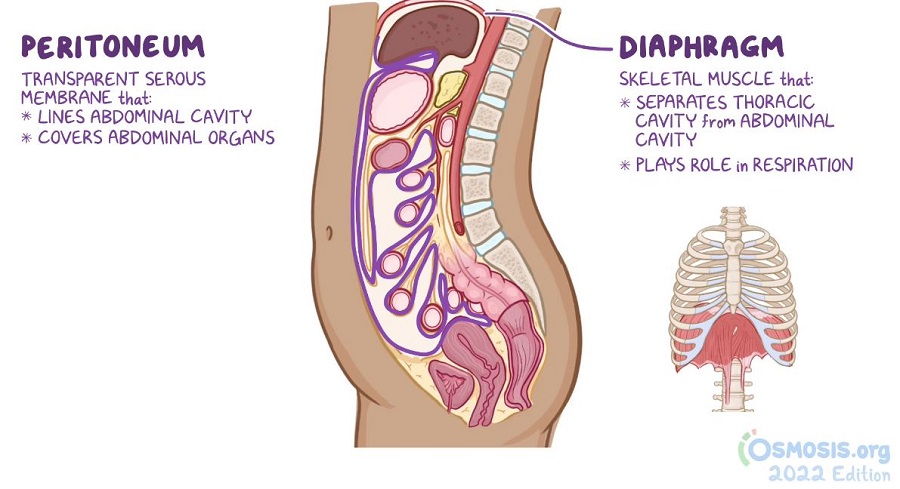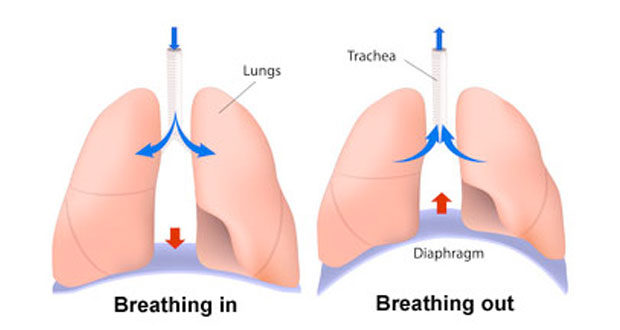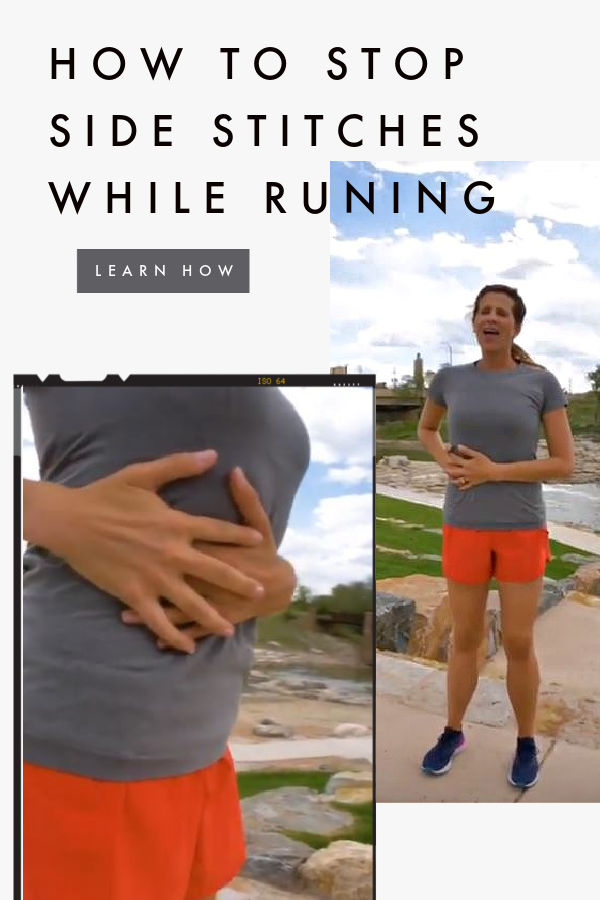If you’ve ever experienced a side stitch while running, you’re not alone.
According to research, 70% of runners have experienced a side stitch in the past year.
You’re cruising along, alright maybe huffing along, when suddenly a cramp in your side stops you in your tracks. Grabbing your rib cage, curl over and then start pulling, twisting and grasping for anything to make it stop.
They suck…the wind right out of you.
While sometimes they happen for no apparent reason, there are some common factors that cause side stitches and easy ways to ensure you don’t become of their victims.
In this article, you’ll learn what they are, what causes them and exactly how to prevent them from ever happening in the first place. Also learn exactly what to do if you’re currently experiencing one.
What is a Side Stitch?
Side stitch is localized pain that’s felt on one side of your abdomen and is also known as exercise-related transient abdominal pain (ETAP). Other names for it include side cramp, side sticker, or side ache.
It normally feels like a sharp, stabbing pain, but it can also feel like dull aching, cramping, or a pulling sensation.
One of the reasons why it’s so common among runners is because it typically occurs when you perform repetitive movements with your torso held upright. Because of this, it happens much less often when swimming or riding a bike.
Usually, this sudden, sharp, or stabbing pain is felt on the right side of the lower abdomen, just below the ribs.
Stitches are twice as common on the right side of older runners than they are on the left. The opposite is true for younger runners.
Seventy percent of runners reported feeling a side stitch in the previous year, according to Sports Medicine research published in 2015.
Side stitches are different than say a calf cramp while running, which is often an overworked muscle, dehydration or electrolyte imbalances.
What Causes a Side Stitch?
In order for us to be able to prevent and even treat side stitches, it’s important to figure out and understand what causes them in the first place. Let’s look at the potential causes of a side stitch.
The Diaphragm and Lungs
The exact cause of a side stitch is still unknown, however one theory is that starts in the diaphragm.
This theory states that it could be due to a strain of the ligaments around your diaphragm which then causes a feeling of cramps or muscle spasms in your side.
The other theory is that it is linked to the lungs. 62% of people report always feeling it on their right side, which could be related to most commonly exhaling when landing with our right foot.
When we breathe the diaphragm rises and falls.
When we run all of our organs and muscles are also rising and falling.
Unfortunately, we’re usually breathing out when we land and that’s when our diaphragm is going up and muscles going down. This is one reason I recommend checking out this article on how to breath while running, which helps guide you to alternate which side you exhale on!
It’s not dangerous. There’s nothing to fix. The body can absolutely handle this…but you have to help it out.
The Peritoneum
The above causes were what scientists believed for the longest time, till a comprehensive review of 14 ETAP studies published in 2015 led to a new theory.
It’s now widely believed that it could be due to friction your abdominal lining. Not your stomach lining, but the lining that goes around all of your organs.
Let’s look at the anatomy of our abdominal lining quickly to understand what that actually means.

The lining of your abdomen is called the peritoneum, and it has two layers.
The inner layer protects the internal organs, while the outer layer rests up against the abdominal wall and wraps around the diaphragm.
To ensure that everything works properly, there should be some room between the two layers.
But when there is friction between the two layers and the space between them gets smaller, the membranes rub against each other. That’s when we feel that sharp pain on the side of our abdomens!
So to understand what causes a side stitch, it’s important to look at what causes this friction to occur in the first place.
The main cause is pressure, namely pressure from the stomach, which reduces the space between the membranes. This can happen after a big meal or if you drink a lot of beverages with a lot of sugar in them.
Additionally, it’s likely that bad posture might contribute to a side stitch.
A study published in the Journal of Science and Medicine in Sport found that those with a rounded upper back are more susceptible to side stitches and experience them more acutely than those with a better posture.
It’s possible that poor posture has an effect on the membrane’s sensitive nerves, making them more susceptible to irritation.
Keeping these things in mind, let’s look at ways we can prevent side stitches while running.
Psychological Factors
A recent study published in the Clinical Journal of Sports Medicine in November 2022 examined the association between ETAP and other factors like anxiety, stress, and sleep disorders because of the inconsistent relationship between cause and effect.
It discovered a moderate association between psychological factors and ETAP frequency, but more research is needed to confirm this correlation.
Keeping these things in mind, let’s look at ways we can prevent side stitches while running.
Symptoms of Side Stitches
The sensation of getting a side stitch varies from person to person. When trying to figure out if someone has a side stitch, it is important to rule out other medical conditions that could have similar symptoms.
Runners who experience abdominal pain can be suffering from a variety of conditions, including muscle cramps, stomach ulcers, gastritis, or even something else entirely.
If you have any doubts, you should consult a doctor; the information presented here is not meant to substitute professional medical advice.
You are most likely to experience the following symptoms if you have a side stitch:
- Sudden onset of pain: The pain may come on suddenly and may be severe enough to make you stop running.
- Cramping or sharp pain: The pain may feel like cramping or a sharp, stabbing sensation.
- Consistent pain: You’ll experience the pain consistently once it starts unless you stop running or exercising
- Location of pain: Pain will be felt most acutely in the upper right quadrant of the abdomen, but may also be present in other areas.
- Pain that worsens with activity: The pain may worsen as you continue to run, especially if you don’t slow down or stop.
- Pain subsides with rest: The pain usually subsides shortly after you stop running or slow down.
- Difficulty breathing: Some runners may experience difficulty breathing or a feeling of tightness in the chest along with the side stitch.
- Dull ache in milder instances: In milder instances, the pain is more likely to feel like a dull ache rather than the usual sharp pain that many runners associate with a side stitch.
How to Prevent Side Stitches While Running
Now that we understand what the potential causes of side stitches are, let’s look at things you can do (or not do) to prevent them while running:
Don’t Eat a Heavy Meal Before Running
In order to digest food, your body needs to send blood and energy to those organs. However, once you start running that is diverted to your muscles and the digestive process is slowed.
This is on top of the fact that eating a big meal before running can cause pressure on your abdominal lining and lead to friction.
Here are some tips to prevent stomach related issues from causing side stitches while running:
- You can train your body to enjoy food pre-run (because we need it!)
- Start with small easily digestible snacks like 1/2 banana with nut butter
- As your run distance increases, slowly increase the amount you eat prior to a run, which will train your body to better deal with food
- Try to eat snacks 30 minutes prior to running and keep full meals at least 2 hours prior to running
For more tips checkout how long to wait after eating to exercise >>
Avoid Sugary Sports Beverages Before Running
We’re all told to carbo load and get in those electrolytes, which is true.
But that high sugar sports drink might be a bad idea. The sugar empties more slowly from the stomach and retains water causing bloating after running, which as noted above presses on the diaphragm.
- Sip your sports drink throughout the run, NO guzzling.
- Alternate drinking water and sports drink at aid stations in a race.
- Avoid super high sugar drinks prior to a run.
- Utilize lower sugar electrolyte powders throughout long runs or after running to help with re-hydrating.
The same issue often arises from using too many gels. The overload of sugar causes a whole slew of things to happen in your gut that can lead to feeling nauseous while running.
Much like with food, you can slowly train your body to better utilize the sports aids for racing and long runs. With our athletes we often refer to this as training your stomach!
Did you know your sports drink could be causing side stitches? #running #marathontraining Click To TweetDon’t Shallow Breathing and Avoid Working Out Too Hard
When we first start running it’s hard. We often make it harder by focusing on a pace that we think we should hit. As a result our effort level is way too high for us to run for very long.
This leads to a change in our breathing patterns, lots of big inhales. Basically, we begin to pant like a dog.
That shallow breathing, leads to the body not receive enough oxygen and the diaphragm then begins to cramp and spasm.
- Read my post on how to breath
- Your belly should be expanding and contracting, not your chest rising and falling
- Focus on perceived effort levels and NOT pace
- Start off with easy runs, adding in speed work only once you are doing those for a few months
- Remember that run walk intervals are also a great way to progress
Focus on Strengthening Weak Core Muscles
Not only will a weak core lead to fatigue, but it plays a role in your posture while running.
You need to be standing tall with shoulders back to take in a full breath and get all the oxygen to your muscles.
Additionally, that stability is likely key to helping with all the movement happening that we mentioned above!
A study published in Journal of Science and Medicine in Sport found that having stronger abdominis muscles led to a decrease in the occurrences of ETAP. These are our deep core muscles that wrap around our spines and act as stabilizers
- Remember to warm up prior to your run, a good place to toss in a core movement like a plank
- Add a core workout to your week at least 2-3 times
- Focus on good running form
Work On Improving Your Posture
As noted above, having poor posture has an effect on the membrane’s sensitive nerves, making them more susceptible to irritation.
It’s important to practice on improving your posture by taking time to straighten out your spine and rolling your shoulders back.
Focus on doing back strengthening exercises to keep your posture in check and inadvertently also help your running form.
How to Get Rid of Side Stitches (3-Step Treatment)
If you’re in the middle of a side stitch while running, none of the above knowledge is useful. You just want to know how to make it go away!
Following are the two most common recommendations. They aren’t Earth shattering, so hopefully the tips to PREVENT will help you no longer need these.
Step 1: Stop Running
The first step is almost always to stop running if that’s an option and switch to breathing in through the nose and then blowing out through the mouth as though pushing air through a straw. Your lips are slightly pursed together.
Step 2: Deep Massage
Press your finger tips in to the side stitch, while massing in a circle and continuing to focus on deep breathing.
You have to get out of chest breathing and in to the belly.
Step 3: Release Tension
Standing tall, reach both arms towards the sky with a big inhale and then let your arms drop to your side with a BIG exhale. Try to exhale for longer than you inhaled.
You can also reach your arms up and try a slow side stretch, again really think about breathing in all the way to your belly and then a big long exhale.
Are Side Stitches Dangerous?
Side stitches are annoying, inconvenient, frustrating, and uncomfortable, but they are rarely severe or cause for concern.
It could hinder performance, but the discomfort is benign.
Side stitches are generally nothing to worry about, but there are more serious conditions that may seem like ETAP. So, this brings up the question of when you should head to the doctor to seek medical attention.
If the pain is acute and stabbing when exercising and does not go away after stopping, it is time to see a doctor.
Also, you shouldn’t have side stitches every time you work out or run. And if the pain starts when you’re not working out, it’s probably not a side stitch.
Make an appointment with your doctor to rule out constipation, a hiatal hernia, or other GI problems. To put it another way, if you have a side stitch for days that are unrelated to your activity level, you probably have something other than the common runner’s stitch.
Also, the first sign of appendicitis can feel like a side stitch. Head to the ER if you have severe lower abdominal discomfort and other symptoms including high fever, vomiting, and/or diarrhea. Also, if you have tightness or pain in your chest and a side stitch, you should go to the emergency room to rule out a cardiac event.
Sadly, the majority of us will experience a side stitch at some point in our lives. Just keep in mind that it’s usually nothing significant, that the pain will pass, and that it is perfectly acceptable to slow down and breathe.
Hopefully, now you know some of the causes and ways you can adjust training to avoid a side stitch while running!
Looking for more ways to improve your runs:
- What’s a Good 5K time?
- Most Common Causes of Knee Pain After Running
- Working Out But Gaining Weight – here’s why
- Best Wireless Running Headphones
- Best Phone Holders for Running
Other ways to connect with Coach Amanda
Instagram Daily Fun: RunToTheFinish
Facebook Community Chatter: RunToTheFinish
Sign Up to Receive a Weekly Newsletter with Top Running Tips and Laughs




 ASICS Vs Adidas Running Shoes: Comparing Models
ASICS Vs Adidas Running Shoes: Comparing Models

Carly
I hope this works!! I have a meet tomorrow!!🤞🏼🏃🏼♀️